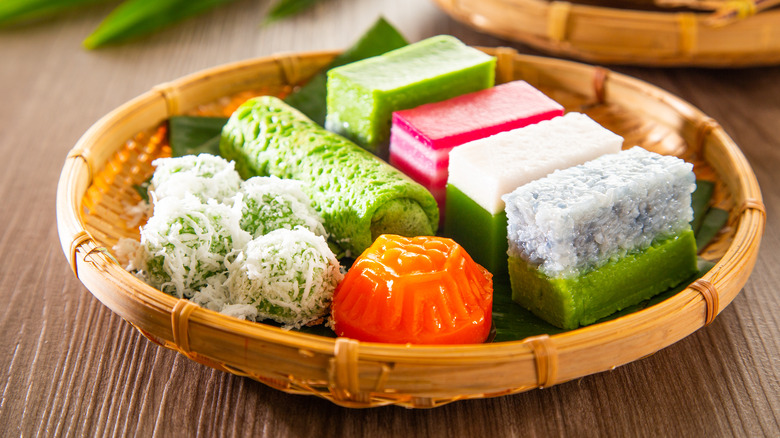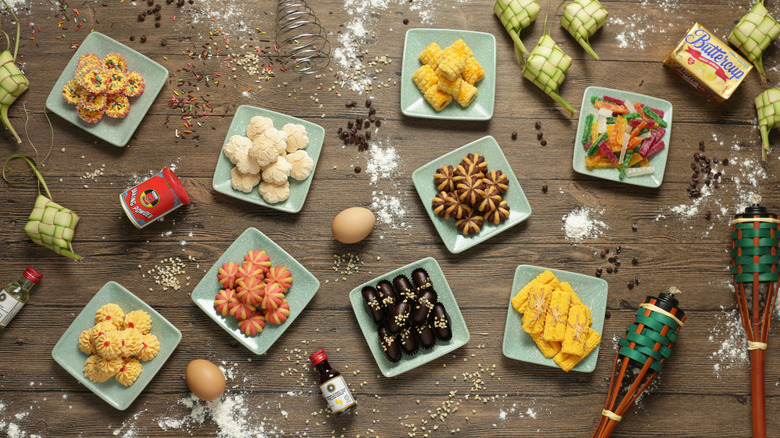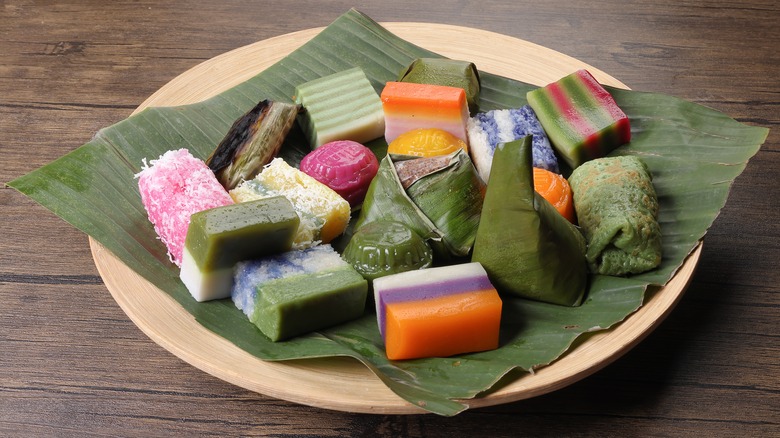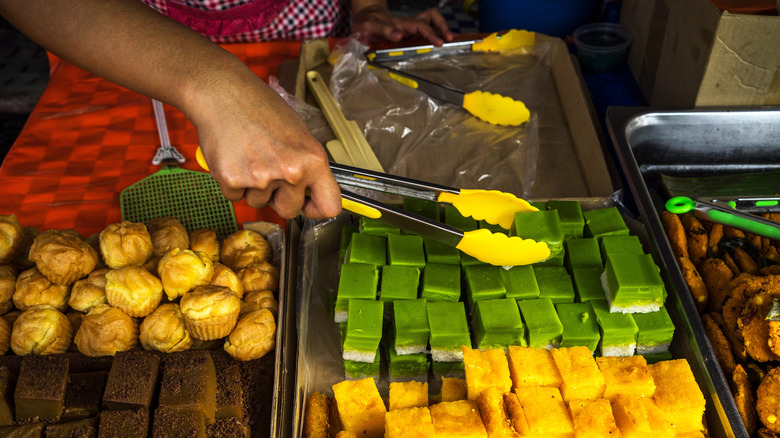Malaysia's Kuih Desserts Are A World Of Colors And Flavors
Malaysia's culinary traditions are among some of the most diverse in Asia. Over centuries, the country's cuisine has become deeply influenced by its neighboring nations and trading partners, per The Journal of Ethnic Foods. As far back as the 15th century, Malaysia's culinary landscape started to shift, starting with a small village. According to the article, Melaka, a once-humble fishing town on the Malaysian Peninsula, grew into a thriving port. It became a hub as traders from abroad brought new spices and vegetables. In turn, Malaysian cuisine became as varied as its new multicultural population. The local cooking started incorporating these not-before-seen ingredients and newly-introduced practices.
Specifically, Arab traders brought with them their religion of Islam, and much of Malaysian cuisine is still halal today. Europeans also voyaged to the region looking for spices with colonial intentions, mainly the Portuguese, Dutch, and English. Through these interactions, Malaysia saw new ingredients such as peanuts, pineapple, avocado, and more. And, while under British rule, the country saw a large influx of Indians and Chinese laborers who also contributed to influencing Malaysia's cuisine, (via The Journal of Ethnic Food).
However, kuih is one of the few remaining areas of Malaysian cuisine that has widely stayed true to its original form, according to Asian Inspirations. Kuih, or kueh, refers to a large range of sweet and savory treats that originate from traditional Malaysian culture, notes The Journal of Ethnic Foods. And, these creative, eye-catching mainstays are worth discovering.
History of kuih
According to Asian Inspirations, while the kuih desserts' flavors and ingredients are distinctively Malaysian, the name kuih is of Chinese origin. Thrillist cites Victor Low, founder and chef, who notes that kings were likely eating kuih, dating back centuries. He told the outlet, "The roots can be traced back to imperial China in the 1400s. The kings back then were all splurging — they didn't have just one meal, but a few hundreds of items on every plate."
This is also why there are likely so many varieties of kuih today. Chefs across China inhabited many different regions of the country. Each region had different ingredients available and differing cuisines. When these chefs wanted to honor the kings through their food, they had to work with the ingredients available to them. Thus, creating so many different forms. And, now that kuih is a part of Southeast Asia, native ingredients to those nations are used, like pandan, coconut, and mung bean. The huge inclusion of these influences has led to hundreds of varieties of kuih.
Kuih is also a food connected strongly with religion. According to the site, kuih is often placed on altars and prayed over, thus giving it strong spiritual connotations. They can be offered to the Gods and eaten for certain religious occasions. The desserts are also often present during holiday celebrations, such as Eid in Malaysia, as per Thrillist.
Ingredients of kuih
Because kuih has mostly stayed true to its original form, its dishes mainly incorporate traditional ingredients, often native to Malaysia. The Journal of Ethnic Foods divides them into five groups: starches, sweeteners, liquids, lipids, and additives.
Starting with starches, rice most often lends starch to many kuih dishes, including glutinous rice. Tubers like tapioca and sweet potatoes are also often used, often for fillings, per The Journal of Ethnic Foods. And, when it comes to sweetening desserts, cane sugar is the most common and traditional ingredient used. Both white sugar and brown sugar can be used depending on the specific recipe. Coconut milk or coconut cream is typically the main liquid used for these desserts. It acts to moisten, providing better texture overall, and adding depth to the flavor. And, oil is the typical lipid used, per Asian Inspirations.
Colorings and flavorings are just as important as the main ingredients. As Asian Inspirations notes, pandan is a common flavor for these desserts, while beet juice, butterfly pea flower flour, and pumpkin are all traditional ingredients used for natural coloring, as kuih desserts often showcase bright hues. These colorings are often symbolic and dyes are placed purposefully in dessert preparations. Certain colors or shapes the desserts are molded into often represent certain attributes, like prosperity or luck. There is intention behind each ingredient, shaping, and coloring when it comes to kuih.
Variations of kuih
There are so many different varieties of beautifully-crafted kuih that it would be impossible to list and describe them all. But, we will give you a rundown of some of our favorites.
Per TimeOut, ang ku kuih, meaning red tortoise cake, is a favorite dessert within the kuih world. As the name implies, the chewy red cake is shaped like a tortoiseshell, and the most common filling is made with mung bean paste. Many variations of this exist, but this original version can often be found alongside other kuih desserts at vendors' stalls at markets. Another popular kuih is kuih lapis. This version is defined by its vibrant colors showcased by being layered on top of one another. From rainbow stripes to layers of blue hues, all kinds of color variations are possible. However, TimeOut notes that red, orange, and white are the most common color combinations.
According to TallyPress, onde-onde are small green spherical cakes filled with gula melaka inside and garnished with grated coconut. The chewy outside can be made with either glutinous rice flour or sweet potato for the main starch, and sometimes a mixture of both is used. With one bite, the filling will burst in the consumers' mouth and the soft outside will satisfyingly pull away. While these are some notable dishes, there is a huge variety of kuih desserts to explore, learn about, and try for yourself.
How kuih are made and eaten
According to The Journal of Ethnic Foods, traditional kuih can be made using a variety of cooking methods, including baking, steaming, boiling, and grilling. However, many of these preparation techniques have come about as a result of foreign influence. Many traditional Malaysian kuih makers continue to do everything by hand, without needing to measure certain ingredients or utilize fancy cookware.
The method of baking their kuih can be done by heating the batters inside metal molds with "charcoal or coconut husks placed on the top and bottom," per the article. For certain variations, they will also often boil or steam ingredients, like pandan leaves, to add more aroma to the kuih. These processes are an integral part of traditional kuih culture and, likewise, Malaysian culture as a whole.
Per Asian Inspirations, kuih can be found all over Malaysia, and it can be eaten nearly any time of day. Whether you prefer a sweet treat solely for dessert, like starting your mornings off with some sugar, or reserve it for an afternoon snack, kuih is the perfect treat for all occasions. Street vendors sell kuih both on street corners in the mornings and at night markets. If you're interested in trying out some of these unique Malaysian delicacies for yourself, it might be worth booking a plane ticket right now.




